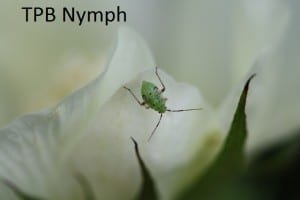 Tarnished plant bug infestations are sporadic and variable, mostly a scout a spray scenario. I’ve had a number of comments, especially from the Mississippi River Bottoms, about seeing more clouded plant bugs than usual. Prior to bloom, I count them as equivalent to tarnished plant bug when sampling and making treatment decisions. Once bolls are present, I suggest counting them as equivalent to 1.5 tarnished plant bugs because they are more inclined to injure bolls. Don’t forget to monitor square retention. The goal is to reach first bloom with at least 80% retention or higher. Remember that the treatment threshold for tarnished plant bug increases to 15/100 sweeps once you reach the third week of squaring. You should adjust this treatment thresholds downward in situations where retention is less than 80-85%.
Tarnished plant bug infestations are sporadic and variable, mostly a scout a spray scenario. I’ve had a number of comments, especially from the Mississippi River Bottoms, about seeing more clouded plant bugs than usual. Prior to bloom, I count them as equivalent to tarnished plant bug when sampling and making treatment decisions. Once bolls are present, I suggest counting them as equivalent to 1.5 tarnished plant bugs because they are more inclined to injure bolls. Don’t forget to monitor square retention. The goal is to reach first bloom with at least 80% retention or higher. Remember that the treatment threshold for tarnished plant bug increases to 15/100 sweeps once you reach the third week of squaring. You should adjust this treatment thresholds downward in situations where retention is less than 80-85%.
Insecticide wise, we did a large plot comparison of adult tarnished plant bug control with Centric (1.75 oz) and Orthene (0.67 lb), and Centric provide good and actually better control than Orthene. Having said that, in older cotton, people are reporting seeing nymphs after applications of imidacloprid or Centric. Last week I suggested that switching chemistries or tank mixing might be needed as we get closer to bloom to prevent this. Tank-mixing imidacloprid or Centric with 4-5 oz/acre of Diamond is one option, Transform (1.5 oz/acre) is another (or perhaps Vydate at 12-16 oz/acre). I am discouraging the use of Acephate/Orthene until we start blooming. It’s just bad resistance management for a very important class of chemistry.
People are reporting seeing more stink bugs around, but they are not a significant problem in cotton unless bolls are present. Ignoring them until we get into flowering is probably the best approach. However, this may be an indication that stink bugs will bounce back after unusually low populations in cotton and soybean in 2017.

